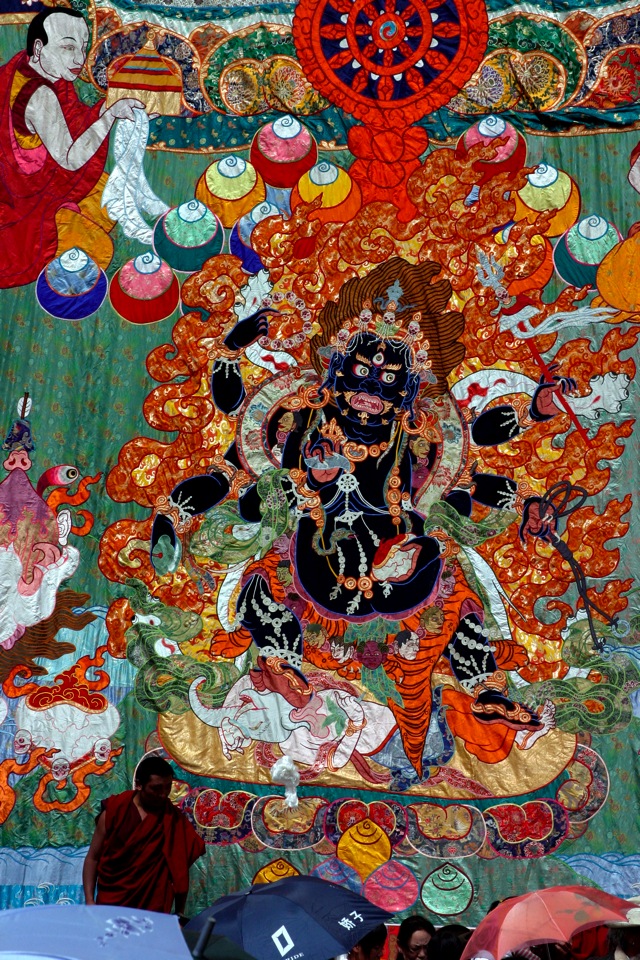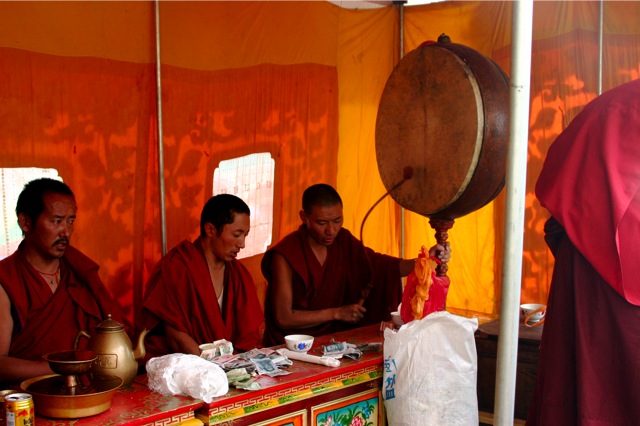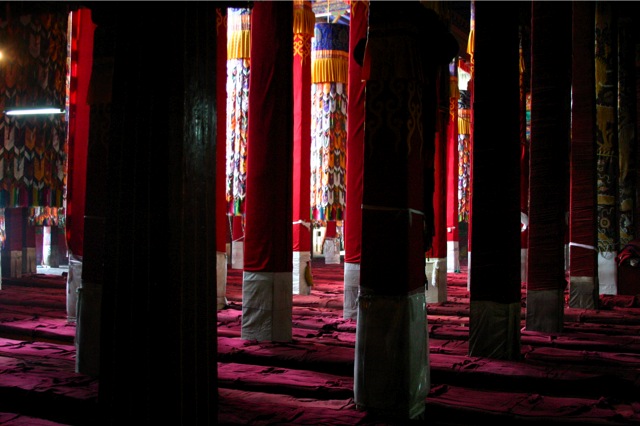
Shötun Festival



Lhasa, six a.m. It rains, although “it never rains in Lhasa.” Niels doesn’t feel good. We sleep a bit more. We feel lukewarm about the Festival (we’re both recuperating from stomach trouble), and eventually decide to take a stroll down the block and buy some stamps.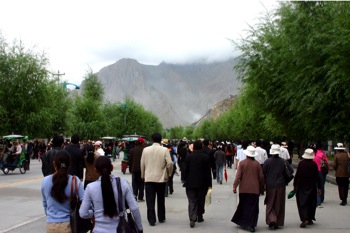

The plan was to leave at six in the morning to see the uncovering of the great thangka at Drepung monastery, the beginning of the Shötun (Yoghurt) festival. I was not feeling so well and it was raining and still dark, so we only got up around nine. We had the vague plan to walk to Sera monastery, where the festival would continue, but then a minibus drove by with a woman yelling “Drepung! Drepung!” so we spontaneously decided to jump on the bus and drive to Drepung.
That is the system here: A driver and a “yeller,” who yells the destination, tries to cajole people onto the bus, and inns the money. 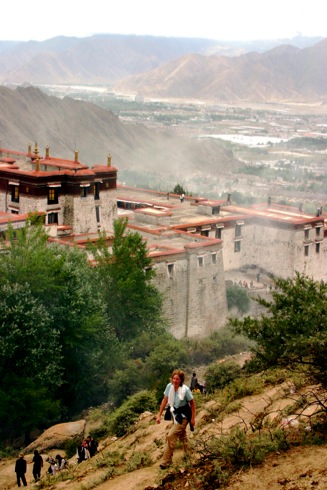 As we drive on, the bus picks up more and more people still, and when we stop after a long queue of other buses, taxis, and cars, we all spill out with the final stretch to Drepung still ahead of us.
As we drive on, the bus picks up more and more people still, and when we stop after a long queue of other buses, taxis, and cars, we all spill out with the final stretch to Drepung still ahead of us.
 As we drive on, the bus picks up more and more people still, and when we stop after a long queue of other buses, taxis, and cars, we all spill out with the final stretch to Drepung still ahead of us.
As we drive on, the bus picks up more and more people still, and when we stop after a long queue of other buses, taxis, and cars, we all spill out with the final stretch to Drepung still ahead of us. First we walked along the main road in a large group of people, and then a side road towards Drepung. Most people were already coming back, but we caught a glimpse of the great thangka on the rock face next to the monastery. Way, way up at the mountainside we spot a colorful rectangle, glued onto the rock like a stamp, it seems - the thangka.
Slowly, the masses ooze onto the long, twisted road up to the monastery. To the left and right, people sell fruit trinkets, and water. Thick heaps of burning incense accompany us, the smoke is sharp and dizzying - escape the fumes of one and already spot the next one around the corner. After the rainy morning it has become very hot, and we slowly creep up the mountain along with all the others, expecting to see the thangka after each curve, and seeing more watermelon vendors instead.
The walk there turned out to be longer and more strenuous (uphill) than we expected, and when we reached the monastery we could no longer see the thangka. Had they already removed it? Disappointed, we decided to at least visit the monastery itself.
When we arrive at the monastery, we are anxious. Has the thangka been covered up again? Where is it? By now, we are climbing up steep, rugged mountain, scrambling through clouds of incense - us and many monks, pilgrims, and other tourists. The sun burns us, precious! We do all of this on a breakfast of tea and dry cookies...
Finally, we take the right turn, and, as a wonderful surprise, spot the thangka. It’s still there! 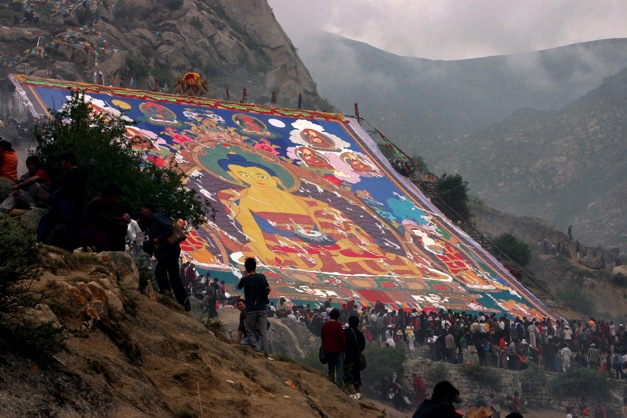

A last scramble up the hill brought us to our goal (good thing we had hiking books, although some women wore high heeled shoes). Enormous and impressive from up close, the thangka gives us an idea of how far we’ve climbed, and it makes it all worthwhile. 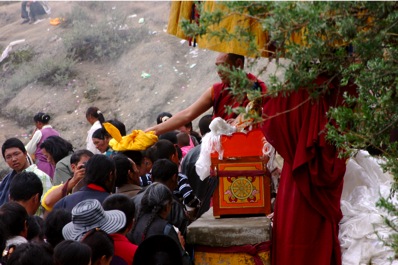 We sit down and soak up the incense and the thangka’s strong colors. Monks are chanting and around us people picnic. The site is quite messy, not pretty at all, but it feels right. A huge spree of activity surrounded the thangka: People praying and prostrating themselves, and tossing white scarves at it.
We sit down and soak up the incense and the thangka’s strong colors. Monks are chanting and around us people picnic. The site is quite messy, not pretty at all, but it feels right. A huge spree of activity surrounded the thangka: People praying and prostrating themselves, and tossing white scarves at it.
 We sit down and soak up the incense and the thangka’s strong colors. Monks are chanting and around us people picnic. The site is quite messy, not pretty at all, but it feels right. A huge spree of activity surrounded the thangka: People praying and prostrating themselves, and tossing white scarves at it.
We sit down and soak up the incense and the thangka’s strong colors. Monks are chanting and around us people picnic. The site is quite messy, not pretty at all, but it feels right. A huge spree of activity surrounded the thangka: People praying and prostrating themselves, and tossing white scarves at it.A thangka, by the way, is a painting of buddhist nature on cloth (we bought one ourselves). Most monasteries have one huge thangka (this one must have been at least 50 meters high) that is displayed once a year.
The monastery itself was also quite beautiful, although few people were inside. Drepung monastery was the seat of the Dalai Lamas before the Potala was built.
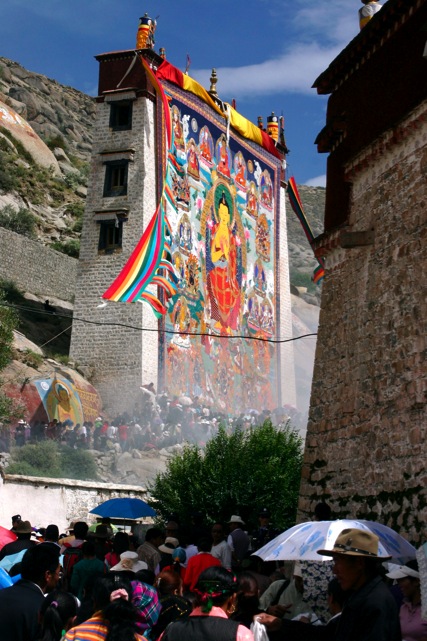
After walking back to the main road, we wanted to go back to the hotel, but all buses went to Sera monastery, so we could only go with the flow. So we hop onto one and take in the second half of the festival, a somewhat milder version of the first.
Luckily, the walk from where the bus dropped us off to Sera’s thangka was not as brutal as in Drepung. Here the thangka was not mounted on the face of the mountain, but on a special purpose building: High, broad, and very flat, making it unlikely the building can be used for anything else.
After Sera the flow of people was back to Lhasa, so we could drop into bed feeling exhausted.
We should have been exhausted, but we feel energized. We also explored both monasteries and let the sun roast us -we hadn’t taken sun lotion because of the rain - and felt great! What a wonderfully insane surprise day it was.
